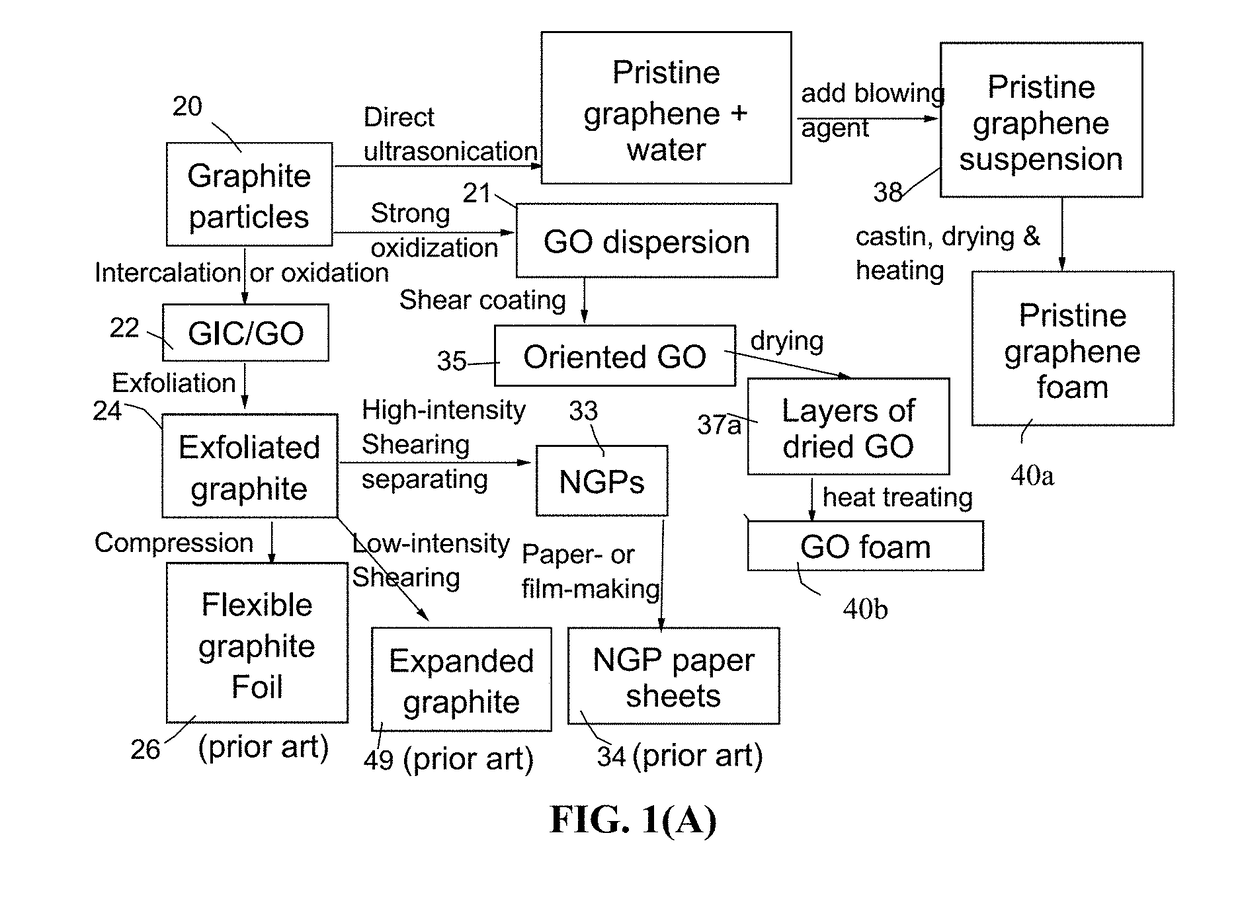Graphene-Metal Hybrid Foam-Based Electrode for an Alkali Metal Battery
a graphene-metal and alkali metal battery technology, applied in the field of alkali metal batteries, to achieve the effect of convenient and convenient housing, high conductive performance and cost-effectiveness
- Summary
- Abstract
- Description
- Claims
- Application Information
AI Technical Summary
Benefits of technology
Problems solved by technology
Method used
Image
Examples
example 1
lowing Agents and Pore-Forming (Bubble-Producing) Processes
[0172]In the field of plastic processing, chemical blowing agents are mixed into the plastic pellets in the form of powder or pellets and dissolved at higher temperatures. Above a certain temperature specific for blowing agent dissolution, a gaseous reaction product (usually nitrogen or CO2) is generated, which acts as a blowing agent. However, a chemical blowing agent cannot be dissolved in a graphene material, which is a solid, not liquid. This presents a challenge to make use of a chemical blowing agent to generate pores or cells in a graphene material.
[0173]After extensive experimenting, we have discovered that practically any chemical blowing agent (e.g. in a powder or pellet form) can be used to create pores or bubbles in a dried layer of graphene when the first heat treatment temperature is sufficient to activate the blowing reaction. The chemical blowing agent (powder or pellets) may be dispersed in the liquid medium...
example 2
on of Discrete Nano Graphene Platelets (NGPs) which are GO Sheets
[0178]Chopped graphite fibers with an average diameter of 12 μm and natural graphite particles were separately used as a starting material, which was immersed in a mixture of concentrated sulfuric acid, nitric acid, and potassium permanganate (as the chemical intercalate and oxidizer) to prepare graphite intercalation compounds (GICs). The starting material was first dried in a vacuum oven for 24 h at 80° C. Then, a mixture of concentrated sulfuric acid, fuming nitric acid, and potassium permanganate (at a weight ratio of 4:1:0.05) was slowly added, under appropriate cooling and stirring, to a three-neck flask containing fiber segments. After 5-16 hours of reaction, the acid-treated graphite fibers or natural graphite particles were filtered and washed thoroughly with deionized water until the pH level of the solution reached 6. After being dried at 100° C. overnight, the resulting graphite intercalation compound (GIC)...
example 2a
on of Metals into Graphene Foam Pores
[0182]For incorporation of higher melting point metals (e.g. Au, Ag, Ni, Co, Mn, Fe, and Ti) as a lithium- or sodium-attracting metal in a graphene foam, a small but controlled amount of the desired metal was deposited on the surfaces of graphene sheets using sputtering, physical vapor deposition, or chemical vapor deposition. It is not necessary to cover the entire graphene surface with metal. These lightly metal-coated graphene sheets are then dispersed in the liquid medium to form a suspension, which is then coated to form a film and then heat treated to form a graphene foam.
[0183]For incorporation of lower melting metals, such as Mg, Zn, Na, K, and Sn, metal melt impregnation or electrochemical infiltration (plating) was implemented after the graphene foam was formed. It may be noted that electrochemical method is applicable to all metals, not just low-melting ones.
[0184]We have observed that it is easier for the single-layer graphene wall-ba...
PUM
| Property | Measurement | Unit |
|---|---|---|
| density | aaaaa | aaaaa |
| pore size | aaaaa | aaaaa |
| density | aaaaa | aaaaa |
Abstract
Description
Claims
Application Information
 Login to View More
Login to View More - R&D
- Intellectual Property
- Life Sciences
- Materials
- Tech Scout
- Unparalleled Data Quality
- Higher Quality Content
- 60% Fewer Hallucinations
Browse by: Latest US Patents, China's latest patents, Technical Efficacy Thesaurus, Application Domain, Technology Topic, Popular Technical Reports.
© 2025 PatSnap. All rights reserved.Legal|Privacy policy|Modern Slavery Act Transparency Statement|Sitemap|About US| Contact US: help@patsnap.com



